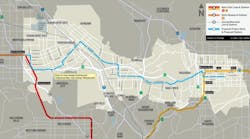L.A. Metro selects HDR to provide final design of North Hollywood to Pasadena BRT Corridor Project
The Los Angeles County Metropolitan Transportation Authority (L.A. Metro) has selected HDR to provide the final design of the North Hollywood to Pasadena Bus Rapid Transit (BRT) Corridor Project. The BRT project will provide faster and more reliable service to meet the corridor’s growth by linking Los Angeles, Burbank, Glendale and Pasadena, Calif. Key destinations include the North Hollywood Arts District, Burbank Media District, Downtown Burbank, Glendale Galleria, Americana at Brand, Eagle Rock Plaza, Old Pasadena and Pasadena City College.
The new BRT is expected to result in travel time savings of 34 to 44 percent compared to existing transit services. The corridor is 19 miles, includes 22 new stations and buses will use dedicated lanes on most of the route. New charging equipment at each end of the line will serve the system’s electric buses.
“The North Hollywood to Pasadena Transit Corridor will significantly reduce travel times for riders on this corridor, improving access to jobs, healthcare and more,” said HDR Principal Engineer Mark Christoffels, who is leading the firm’s work. “It’s great to work on projects that make such a tangible contribution to people’s everyday lives.”
HDR will provide a variety of design services, including civil and roadway, station, traffic and more. Coordination among the many stakeholders and agencies is critical to success. The project is being delivered via the construction manager/general contractor approach. Working with the contractors, HDR has dedicated teams to each jurisdiction to accelerate progress in each section and help avoid unnecessary delays.
“Designing a multi-jurisdictional corridor isn’t something every team can take on and I’m proud that HDR was chosen for this complex project,” said HDR Global Transit Director Matt Tucker. “This BRT will provide better transit options to busy neighborhoods in need of improved mobility options and I’m looking forward to seeing the new service in operation a few years from now.”
Construction on the corridor is expected to begin in 2025, with revenue service scheduled for 2027.




